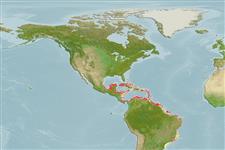Classification / Names
Common names from other countries
Main reference
Size / Weight / Age
Max length : 18.2 cm TL male/unsexed; (Ref. 71685); 17.1 cm TL (female); common length : 15.0 cm TL male/unsexed; (Ref. 5217)
Length at first maturity
Lm 13.7 range ? - ? cm
Environment
Marine; brackish; pelagic-neritic; depth range 10 - ? m
Climate / Range
Tropical, preferred 27°C (Ref. 107945); 23°N - 28°S, 98°W - 32°W (Ref. 189)
Distribution
Western Atlantic: in the Antilles, from Cuba southward; Costa Rica south and east to Colombia and Venezuela, Trinidad south to Itapema, Santa Catarina, Brazil.
Countries | FAO areas | Ecosystems | Occurrences | Introductions
Short description
Dorsal
spines
(total): 0;
Anal
spines: 0;
Anal
soft rays: 18 - 24. Head large and deep. Snout short and pointed, about 2/3 eye diameter; maxilla moderate, tip blunt, just failing to reach lower jaw articulation; fine and numerous lower gill rakers, increasing in large fishes; no gill rakers on posterior face of third epibranchial. Branchiostegal rays 8, long and slender; branchiostegal membrane broad. Silver stripe disappearing at about 10 cm SL (Ref. 189). Dusky dots on upper surface of head and snout, series of large black dots along base of anal (Ref. 37032).
IUCN Red List Status (Ref. 115185)
Threat to humans
Harmless
Human uses
Fisheries: minor commercial; bait: usually
More information
ReferencesAquacultureAquaculture profileStrainsGeneticsAllele frequenciesHeritabilityDiseasesProcessingMass conversion
Tools
Special reports
Download XML
Internet sources
Estimates of some properties based on models
Phylogenetic diversity index
PD50 = 0.7500 many relatives (e.g. carps) 0.5 - 2.0 few relatives (e.g. lungfishes)
Trophic Level
2.1 ±0.07 se; Based on food items.
Resilience
Medium, minimum population doubling time 1.4 - 4.4 years (K=0.13-0.22)
Vulnerability
Moderate vulnerability (44 of 100)
Price category
